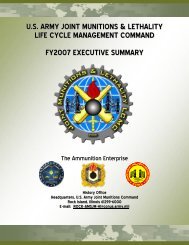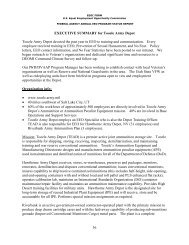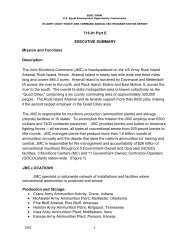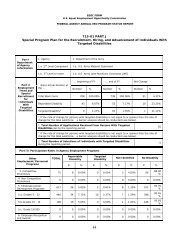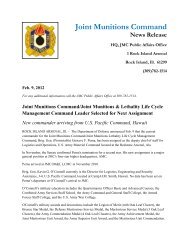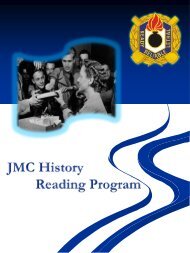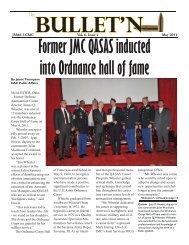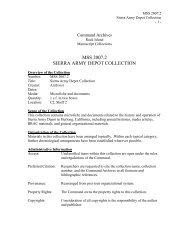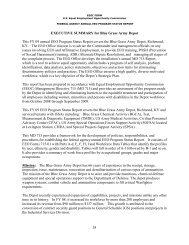History of the Ammunition Industrial Base - JMC - U.S. Army
History of the Ammunition Industrial Base - JMC - U.S. Army
History of the Ammunition Industrial Base - JMC - U.S. Army
You also want an ePaper? Increase the reach of your titles
YUMPU automatically turns print PDFs into web optimized ePapers that Google loves.
were made in <strong>the</strong> reverse nitration <strong>of</strong> TNT, toluene extraction from petroleum, mechanization <strong>of</strong><br />
loading, and <strong>the</strong> development and use <strong>of</strong> wood pulp, RDX and rocket powder. 40<br />
During WWII doctrine had also evolved. U.S. <strong>Army</strong> field commanders paved <strong>the</strong> way<br />
for advancing foot soldiers by use <strong>of</strong> massed artillery fire and aerial bombing instead <strong>of</strong><br />
exercising frontal infantry attacks. For example, in <strong>the</strong> first days <strong>of</strong> attacks on Cassino, U.S.<br />
artillery units fired around 11,000 tons <strong>of</strong> shells which were accompanied by fire storms <strong>of</strong><br />
bombs from <strong>the</strong> air. Carpet bombing was also practiced across <strong>the</strong> <strong>the</strong>ater. Therefore,<br />
expansion <strong>of</strong> <strong>the</strong> artillery ammunition base started on a modest scale in 1940. During 1941<br />
expansion gained momentum as work on 25 new plants began and existing plant capacities were<br />
greatly increased. Thirteen <strong>of</strong> <strong>the</strong> new plants were for loading operations. Between January and<br />
August 1942, construction started on an additional 25 plants. 41 The rate <strong>of</strong> artillery expenditure<br />
during WWII required <strong>the</strong> operation <strong>of</strong> 60 artillery ammunition plants. See Appendix A for a<br />
listing <strong>of</strong> ammunition facilities to include small arms, explosive, propellant, and LAP facilities<br />
operated in WWII to support requirements.<br />
In 1944, new ordnance directives ordered doubled <strong>the</strong> monthly production rate <strong>of</strong><br />
artillery in seven months and to triple <strong>the</strong> amount in 14 months. The OD warned leaders <strong>of</strong> high<br />
expenditure rates and <strong>the</strong> need to produce more artillery and <strong>the</strong>ir predictions were accurate.<br />
Leaders reacted quickly and continued building up <strong>the</strong> artillery base. Several plants that had<br />
been shut down were reopened and re-equipped at record paces. During early 1945, heavy<br />
artillery expenditure rates reached record highs. The total for all types and sizes <strong>of</strong> artillery<br />
ammunition reached nearly 1 billion rounds. The value <strong>of</strong> artillery ammunition produced<br />
between Pearl Harbor and V-J Day was nearly $7 billion at 1945 prices. In addition, over one<br />
hundred million grenades and mines were produced along with 33 million bombs. 42<br />
In comparison to artillery production small caliber ammunition was simpler and easier to<br />
produce since it did not involve fuzes and loading <strong>of</strong> high explosives. Even so, <strong>the</strong> mass<br />
production <strong>of</strong> high quality small arms ammunition required equally exacting measures to meet<br />
quality specifications. Three major families <strong>of</strong> small arms ammunition were.30, .45, and .50<br />
calibers with five main types: ball, armor piercing, armor piercing incendiary, incendiary, and<br />
tracer produced over <strong>the</strong> course <strong>of</strong> WWII. Before WWII, Frankford Arsenal was <strong>the</strong> only plant<br />
in <strong>the</strong> U.S. producing military grade small arms ammunition. Several commercial firms<br />
(Remington, Western, and Winchester) made sporting ammunition, but <strong>the</strong> difference between<br />
sporting and military ammunition was incomparable. In 1936 and 1937, ordnance reps met<br />
frequently with Remington Arms Company with goals to have Remington expand its capacity in<br />
<strong>the</strong> event <strong>of</strong> wartime emergencies and to also take over operation <strong>of</strong> proposed new government<br />
plants. After discussions, President <strong>of</strong> Remington, Mr. C.K. David, agreed with a formal<br />
statement <strong>of</strong> <strong>the</strong> plan drawn up by Frankford Arsenal. This was <strong>the</strong> first <strong>of</strong> many actions to rally<br />
commercial small caliber ammunition producers to augment government capabilities. The rate<br />
<strong>of</strong> small caliber expenditure during WWII required <strong>the</strong> operation <strong>of</strong> 16 GOCO plants. 43<br />
In <strong>the</strong> late 1930s, Frankford obtained funding for new machinery and equipment due to<br />
ordnance actions to modernize arsenals. In 1939, Frankford gained additional funding to expand<br />
40 Ibid, 133-144.<br />
41 Ibid, 107.<br />
42 Ibid, 105.<br />
43 Ibid, Chapter IX.<br />
15



